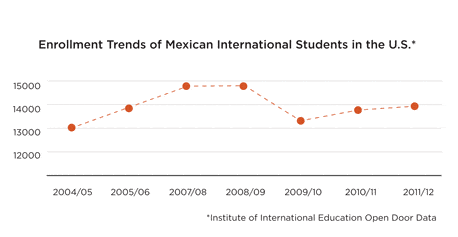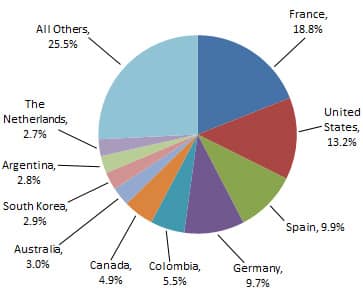Mexico’s higher education sector eyeing expansion
Recently, Mexico and the United States announced new education links and agreed that improved student mobility in both directions could produce strong long term benefits for both countries. Today, ICEF Monitor takes a look at Mexico’s higher education sector, its relationship with the US and other countries, and offers tips on how to access the Mexican market.
Mexico and its northern neighbour
In early May, Mexican president Enrique Peña Nieto and US president Barack Obama jointly announced the formation of a Bilateral Forum on Higher Education, Innovation, and Research. The goals include:
- "encourage broader access to quality post-secondary education for traditionally underserved demographic groups, especially in the science, technology, engineering, and mathematics (STEM) fields;
- expand educational exchanges;
- increase joint research on education and learning;
- share best practices in higher education and innovation."
President Nieto said during the joint announcement:
“In order to compete with the world, specifically the highly developed countries where science and technology have been the target of their efforts and investment, it is fundamental that we have well-prepared youngsters with the skills necessary to give our economic development a greater strength and a greater capacity.”
To that end, both governments have pledged to build upon the educational and research linkages that already exist through federal, state, and local governments, public and private academic institutions, civil society, and the private sector. In addition, Obama has outlined what he calls “100,000 Strong in the Americas” - a plan to increase the number of exchange students in all of the Americas: "With approximately 40,000 US students studying in Latin America and the Caribbean and 60,000 Latin American and Caribbean students studying in the US each year, the goal is ambitious. We are seeking to more than double the number of exchange students in our region in less than ten years. Many Latin American and Caribbean students, particularly those of indigenous and Latinos of African descent, do not have the English language skills or resources to be successful at US universities. Conversely, many US students are unaware of the opportunities available in the hemisphere, and US colleges and universities are not set up to send large numbers of students abroad, facing obstacles such as how to transfer course credits, arranging tuition agreements, and how to handle off-cycle semesters."
US-Mexico student mobility numbers
According to IIE's 2012 Open Doors Report, in the 2011/12 academic year, 13,893 students from Mexico were studying in the United States. While this represents a 1.3% increase over the previous year, it is still considered to be a low number when one considers, for instance, the 72,295 students in the US from South Korea.
Mexican enrolments sagged in 2009 as the global recession took hold, however indicators are moving upward again and Mexico currently sends the ninth most international students to the US. About 54% are undergraduates, and approximately 40% study business and engineering.

Mexico's inbound/outbound student mobility
Higher education institutions in Mexico serve over 2.5 million students, which is about 30% of the university age population, and the government hopes to expand this to 50% by 2020. However, some observers note that fee increases at universities over the last few years have the potential to cause more students to seek opportunities abroad.
As a destination, the largest number of international students in Mexico - according to the Patlani Report's 2010/11 data - came from France, at 18.8%. The next highest senders were the United States (13.2%), Spain (9.9%), Germany (9.7%), Colombia (5.5%) and Canada (4.9%). Also contributing were Australia, South Korea, Argentina, and the Netherlands.

"In the past decade, more than 50 million people have worked their way up the social ladder and into the middle classes – an increase of more than 50% that means now almost a third of Latin Americans are classifiable as middle class. This generation has high aspirations for their children and wants to see them secure the best education possible. At the same time, most governments in the region have started addressing low rates of higher education participation – more scholarships, increased sponsorship and greater social mobility has resulted in half a million more people enrolling in higher education in 2010/11 than in 2006/07 in Mexico alone."
Mexican public and private colleges have been forming alliances with schools around the world to provide joint programmes, dual certification, and exchange programmes for students and professors. For example, France and Québec City maintain agreements with Mexican technical universities to promote student mobility. These agreements comprise 60 Mexican technological universities, 114 French technological institutes and 48 public colleges (CEGEPs) from Québec.
Opportunities in Mexico's education sector
Mexico is expected to develop a huge market for online learning due to President Nieto’s promises of creating a national online virtual university. Nieto’s planned National Digital University is one plank in a strategy to increase university enrolment by 50% by 2018, which would mean creating another 1.5 million spots. The idea of a digital university fits with rising trends in Internet usage. About 40 million Mexicans, most of them 18 to 34 years old, use the Internet daily. MOOC provider Coursera sees growth potential as well, linking with two Mexican universities - Tecnológico de Monterrey and La Universidad Nacional Autónoma de México - to offer online courses. In terms of social media, Mexico’s Facebook usage has exploded in the last two years, ranking the country as one to watch on the company’s growth charts. Mexico is also in the top 15 countries for Twitter growth. Currently 90% of all Mexican Internet users have a profile on at least one social media site. A Nuffic Neso Mexico survey revealed that for Mexican students, the Internet is the most important source of information for international schooling, indicating that in the future, this is where educators increasingly will need to connect with prospective applicants. Along with Mexico’s wholesale embrace of Internet technology and the contact opportunities it represents, participation in education fairs remains an effective tool for attracting Mexican students. The International Education Mexico EXPO Roadshow received more than 22,000 students for its 2013 fair, and the organisation already has a registration website up for 2014. An even larger fair, EuroPosgrados, focuses entirely on graduate programmes in Europe. The October 2013 version is slated for three cities, Puebla, León and Monterrey, each chosen for their student population, higher education institutions, and geographical location. The fair is organised by Nuffic, DAAD, Campus France, and Universidad España.
Challenges for Mexico
There remain issues for the Mexican education sector and government to address moving forward. For instance, a recent survey of over 400 universities found that only about 18% work with businesses and organisations in teacher development, and only 16% have small business incubators. Both percentages are considered to be far below optimal levels. Sergio Cárdenas, professor and researcher with Mexican-based think-tank CIDE, emphasised,
“Despite a larger budget and a greater number of government programmes to encourage collaboration, the majority of activities involving university-industry cooperation are still incomplete and a mismatch between universities and businesses in developing research opportunities persists.”Questions about the quality of university education in Mexico
have arisen in recent years. With the majority of Mexican students attending public universities, space restrictions at those schools have allowed private institutions to rush in and fill the void. Calls for the government to more strictly regulate these new private institutions and implement quality control measures may create added pressures as Mexico advances towards its goal of boosting overall tertiary enrolment. Another obstacle is the lack of low cost, widespread Internet access. This may dampen the scale and speed of adoption for online education and recruitment techniques. Finally, Mexico’s well-publicised security problems are also a concern. The issues there are real, with violence ensnaring innocent bystanders and even leading to exam cancellations in Guadalajara last year. For educators, agents, and students, finding partners on the ground in Mexico can help pinpoint the safest areas and ease concerns, because locals are at least able to tell a more nuanced story about safety than that heard in the news.
More resources
There are a number of associations offering information and assistance on Mexico. The following is a starter list:
- Asociación Mexicana para la Educación Internacional (AMPEI): a non-profit national association whose mission is to help strengthen the academic quality of Mexican education institutions through international cooperation. AMPEI carries out various activities related to the training of professionals and academic exchange via workshops, promotion of academic exchanges and collaboration between HE institutions in Mexico and abroad, and research and analysis of management processes of academic exchange activities.
- The Consortium of North American Higher Education Collaboration (CONAHEC): fosters cooperation in North American via collaboration between institutions of higher education in Canada, Mexico and the United States.
- The Asociación Nacional de Universidades e Instituciones de Educación Superior (ANUIES): an organisaton of over 150 universities and institutions that carries out strategic national studies and promotes the improvement of quality and development of the programmes and services offered by affiliated institutions.
- Consejo Mejicano de Asuntos Internacionales (COMEXI): encourages study, analysis, and dialogue on international relations of Mexico in the context of globalisation.
- Becas MOB: an association of excellence that supports higher education and university graduates via promoting high-level education, granting scholarships for master's abroad.
- The Mexico-US Commission for Educational and Cultural Exchange (COMEXUS): oversees the Fulbright-Garcia Robles Scholarship Program, through which over 4,000 Mexicans and Americans have participated in bilateral exchange programmes since 1990. This organisation also has scholarship and visa information.
- The National Council for Science and Technology (CONACYT): offers funding, mainly for joint research programmes and scholarships for master’s or PhD students.















